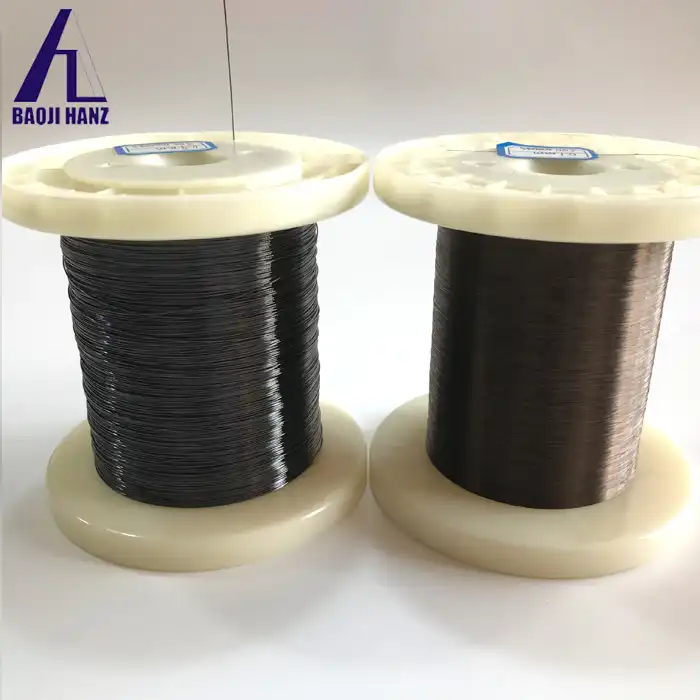Why choose nitinol guide wire?
2024-08-09 20:45:59
In the realm of medical devices, the Nitinol guide wire stands out for its exceptional properties and wide range of applications. As the medical field continues to advance, the demand for high-performance materials like Nitinol is increasing. This blog explores the compelling reasons why Nitinol guide wires are chosen over other options and addresses several critical questions that frequently arise. We will also delve into the benefits and challenges associated with this innovative material, providing a comprehensive overview of why Nitinol guide wires are an optimal choice for modern medical procedures.
What Makes Nitinol Guide Wires Unique?
Nitinol, a nickel-titanium alloy, is renowned for its unique combination of properties, including superelasticity and shape memory. These characteristics make Nitinol guide wires a preferred choice in various medical procedures. The alloy's ability to return to its original shape after deformation is particularly beneficial in navigating complex anatomical structures.
Key Properties of Nitinol:
- Superelasticity: Nitinol guide wires can withstand significant deformation and still return to their original shape. This property is crucial for navigating tight or irregular pathways within the body.
- Shape Memory Effect: Nitinol can "remember" its original shape, making it ideal for procedures that require precision and stability.
- Biocompatibility: The alloy is well-tolerated by the human body, reducing the risk of adverse reactions.
These properties ensure that Nitinol guide wires provide superior performance compared to traditional materials, making them indispensable in advanced medical procedures.
How Does Nitinol Improve Medical Procedures?
The integration of Nitinol guide wires into medical procedures offers several advantages, particularly in minimally invasive surgeries and complex interventions.
Improved Navigation and Precision: Nitinol guide wires are particularly useful in navigating complex or tortuous pathways due to their flexibility and strength. This allows for greater precision during procedures, reducing the risk of complications and improving patient outcomes.
Enhanced Patient Safety: The biocompatibility and superelasticity of Nitinol guide wires contribute to safer procedures. The reduced risk of breakage or deformation enhances overall patient safety, making Nitinol an excellent choice for critical medical applications.
Minimally Invasive Techniques: Nitinol guide wires enable minimally invasive procedures by allowing for smaller incisions and less trauma to surrounding tissues. This results in faster recovery times and less discomfort for patients.
What Are the Challenges of Using Nitinol Guide Wires?
While Nitinol guide wires offer numerous benefits, there are also challenges associated with their use. Understanding these challenges can help in optimizing their application and addressing potential issues.
Cost Considerations: Nitinol is a specialized material, and its production can be more expensive compared to traditional metals. This can impact the overall cost of medical procedures and devices.
Manufacturing Complexities: The production of Nitinol guide wires requires advanced technology and precise control over alloy composition and processing. Ensuring consistent quality and performance can be challenging.
Handling and Sterilization: Due to their unique properties, Nitinol guide wires require careful handling and sterilization to maintain their performance and safety. Proper procedures must be followed to avoid compromising their functionality.
Conclusion
Nitinol guide wires represent a significant advancement in medical technology, offering unparalleled performance and safety benefits. Their unique properties, such as superelasticity and shape memory, make them indispensable for modern medical procedures. Despite some challenges, the advantages of using Nitinol guide wires far outweigh the potential drawbacks, making them a valuable asset in the field of medicine.
Baoji Hanz Metal Material Co., Ltd. is at the forefront of Nitinol innovation, committed to delivering high-quality materials and solutions. Established on November 15, 2017, the company is located in the Baoji Titanium Valley Nonferrous Metals Base in China. With a complete set of sophisticated production and processing equipment, excellent technology, and a professional sales and after-sales team, Baoji Hanz specializes in Nitinol shape memory alloy, superelastic Nitinol alloy, nickel-titanium alloy, and more. The company focuses on converting scientific research results into practical applications, broadening new ideas for material purification, processing, and preparation.
For more information or inquiries, please contact us at baojihanz-niti@hanztech.cn.
References
- "Nitinol: The Shape Memory Alloy." Materials Science and Engineering.
- "The Use of Nitinol in Medical Devices." Journal of Biomedical Materials Research.
- "Advantages and Challenges of Nitinol Guide Wires." Medical Device Technology.
- "Nitinol: An Overview of Properties and Applications." Advanced Materials.
- "Nitinol in Minimally Invasive Surgery." Surgical Technology International.
